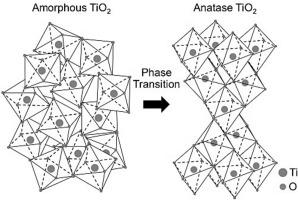Structurally reordered crystalline atomic layer-dielectric hybrid metasurfaces for near-unity efficiency in the visible
IF 22
1区 材料科学
Q1 MATERIALS SCIENCE, MULTIDISCIPLINARY
引用次数: 0
Abstract
Metasurfaces, consisting of sub-wavelength scale nanostructures, have garnered significant attention as promising alternatives to conventional optical elements. However, traditional metasurfaces are often limited by material inefficiencies, fabrication complexity, and challenges in achieving seamless integration with standard semiconductor equipment. Here, we propose highly efficient crystalline titanium dioxide (TiO2)-silicon dioxide (SiO2) hybrid metasurfaces, fabricated using plasma-enhanced atomic layer deposition. By recrystallizing the state of the TiO2 atomic layer under optimized deposition conditions, we significantly increase the refractive index by 0.43 at a wavelength of 400 nm compared to its minimum value. Our hybrid metasurfaces, constructed by directly etching nanostructures into SiO2 substrates, substantially enhance cross-polarization transmittance, offering near-unity efficiencies across red (from 1 % to 95 %), green (from 3 % to 95 %), and blue (from 5 % to 75 %) wavelengths. We apply these hybrid metasurfaces to achieve diffraction-limited imaging with large-aperture 5 mm-sized metalenses in each color. This hybrid metasurface paves the way for real-world applications by extending SiO2—widely used in the industry but previously limited by its low refractive index—into a high-efficiency metasurface material for the visible spectrum.

结构重排的晶体原子层-介电杂化超表面在可见光下接近统一效率
由亚波长尺度纳米结构组成的超表面,作为传统光学元件的有希望的替代品,已经引起了人们的极大关注。然而,传统的超表面通常受到材料效率低下,制造复杂性以及与标准半导体设备实现无缝集成的挑战的限制。在这里,我们提出了高效的结晶二氧化钛(TiO2)-二氧化硅(SiO2)杂化超表面,采用等离子体增强原子层沉积制备。通过在优化的沉积条件下对TiO2原子层的状态进行再结晶,我们在400 nm波长处的折射率比最小值显著提高了0.43。我们的混合超表面是通过直接将纳米结构蚀刻到SiO2衬底上构建的,大大提高了交叉极化透过率,在红色(从1%到95%),绿色(从3%到95%)和蓝色(从5%到75%)波长上提供接近统一的效率。我们将这些混合超表面应用于每种颜色的大孔径5毫米大小的超透镜,以实现衍射限制成像。这种混合超表面为实际应用铺平了道路,将二氧化硅(在工业中广泛使用,但以前因其低折射率而受到限制)扩展为可见光谱的高效超表面材料。
本文章由计算机程序翻译,如有差异,请以英文原文为准。
求助全文
约1分钟内获得全文
求助全文
来源期刊

Materials Today
工程技术-材料科学:综合
CiteScore
36.30
自引率
1.20%
发文量
237
审稿时长
23 days
期刊介绍:
Materials Today is the leading journal in the Materials Today family, focusing on the latest and most impactful work in the materials science community. With a reputation for excellence in news and reviews, the journal has now expanded its coverage to include original research and aims to be at the forefront of the field.
We welcome comprehensive articles, short communications, and review articles from established leaders in the rapidly evolving fields of materials science and related disciplines. We strive to provide authors with rigorous peer review, fast publication, and maximum exposure for their work. While we only accept the most significant manuscripts, our speedy evaluation process ensures that there are no unnecessary publication delays.
 求助内容:
求助内容: 应助结果提醒方式:
应助结果提醒方式:


